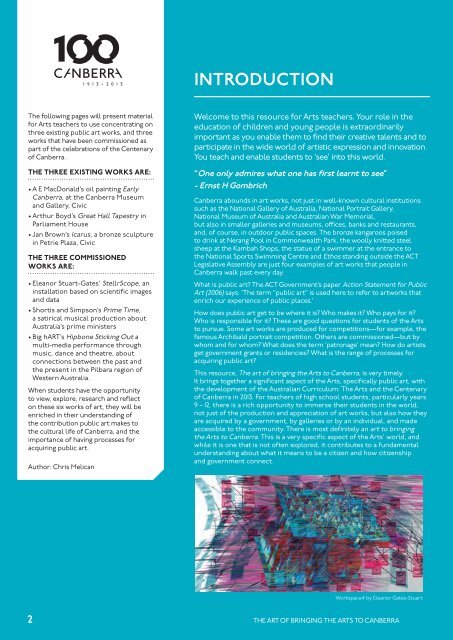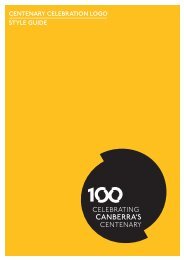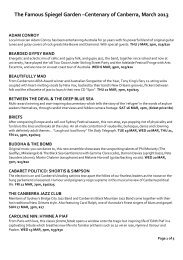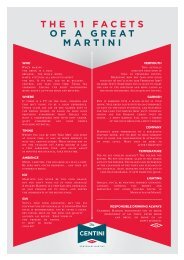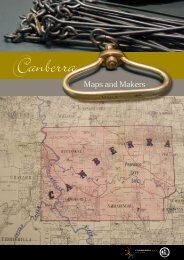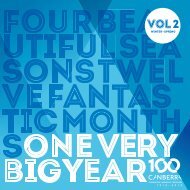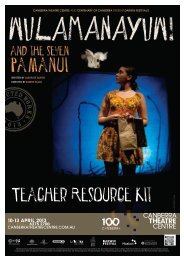THE ART - Canberra 100
THE ART - Canberra 100
THE ART - Canberra 100
You also want an ePaper? Increase the reach of your titles
YUMPU automatically turns print PDFs into web optimized ePapers that Google loves.
INTRODUCTION<br />
The following pages will present material<br />
for Arts teachers to use concentrating on<br />
three existing public art works, and three<br />
works that have been commissioned as<br />
part of the celebrations of the Centenary<br />
of <strong>Canberra</strong>.<br />
<strong>THE</strong> THREE EXISTING WORKS ARE:<br />
••<br />
A E MacDonald’s oil painting Early<br />
<strong>Canberra</strong>, at the <strong>Canberra</strong> Museum<br />
and Gallery, Civic<br />
••<br />
Arthur Boyd’s Great Hall Tapestry in<br />
Parliament House<br />
••<br />
Jan Brown’s Icarus, a bronze sculpture<br />
in Petrie Plaza, Civic<br />
<strong>THE</strong> THREE COMMISSIONED<br />
WORKS ARE:<br />
••<br />
Eleanor Stuart-Gates’ StellrScope, an<br />
installation based on scientific images<br />
and data<br />
••<br />
Shortis and Simpson’s Prime Time,<br />
a satirical musical production about<br />
Australia’s prime ministers<br />
••<br />
Big h<strong>ART</strong>’s Hipbone Sticking Out a<br />
multi-media performance through<br />
music, dance and theatre, about<br />
connections between the past and<br />
the present in the Pilbara region of<br />
Western Australia.<br />
When students have the opportunity<br />
to view, explore, research and reflect<br />
on these six works of art, they will be<br />
enriched in their understanding of<br />
the contribution public art makes to<br />
the cultural life of <strong>Canberra</strong>, and the<br />
importance of having processes for<br />
acquiring public art.<br />
Author: Chris Melican<br />
Welcome to this resource for Arts teachers. Your role in the<br />
education of children and young people is extraordinarily<br />
important as you enable them to find their creative talents and to<br />
participate in the wide world of artistic expression and innovation.<br />
You teach and enable students to ‘see’ into this world.<br />
“One only admires what one has first learnt to see”<br />
- Ernst H Gombrich<br />
<strong>Canberra</strong> abounds in art works, not just in well-known cultural institutions<br />
such as the National Gallery of Australia, National Portrait Gallery,<br />
National Museum of Australia and Australian War Memorial,<br />
but also in smaller galleries and museums, offices, banks and restaurants,<br />
and, of course, in outdoor public spaces. The bronze kangaroos poised<br />
to drink at Nerang Pool in Commonwealth Park, the woolly knitted steel<br />
sheep at the Kambah Shops, the statue of a swimmer at the entrance to<br />
the National Sports Swimming Centre and Ethos standing outside the ACT<br />
Legislative Assembly are just four examples of art works that people in<br />
<strong>Canberra</strong> walk past every day.<br />
What is public art? The ACT Government’s paper Action Statement for Public<br />
Art (2006) says: ‘The term “public art” is used here to refer to artworks that<br />
enrich our experience of public places.’<br />
How does public art get to be where it is? Who makes it? Who pays for it?<br />
Who is responsible for it? These are good questions for students of the Arts<br />
to pursue. Some art works are produced for competitions—for example, the<br />
famous Archibald portrait competition. Others are commissioned—but by<br />
whom and for whom? What does the term ‘patronage’ mean? How do artists<br />
get government grants or residencies? What is the range of processes for<br />
acquiring public art?<br />
This resource, The art of bringing the Arts to <strong>Canberra</strong>, is very timely.<br />
It brings together a significant aspect of the Arts, specifically public art, with<br />
the development of the Australian Curriculum: The Arts and the Centenary<br />
of <strong>Canberra</strong> in 2013. For teachers of high school students, particularly years<br />
9 – 12, there is a rich opportunity to immerse their students in the world,<br />
not just of the production and appreciation of art works, but also how they<br />
are acquired by a government, by galleries or by an individual, and made<br />
accessible to the community. There is most definitely an art to bringing<br />
the Arts to <strong>Canberra</strong>. This is a very specific aspect of the Arts’ world, and<br />
while it is one that is not often explored, it contributes to a fundamental<br />
understanding about what it means to be a citizen and how citizenship<br />
and government connect.<br />
Workspace4 by Eleanor Gates-Stuart<br />
2 <strong>THE</strong> <strong>ART</strong> OF BRINGING <strong>THE</strong> <strong>ART</strong>S TO CANBERRA


